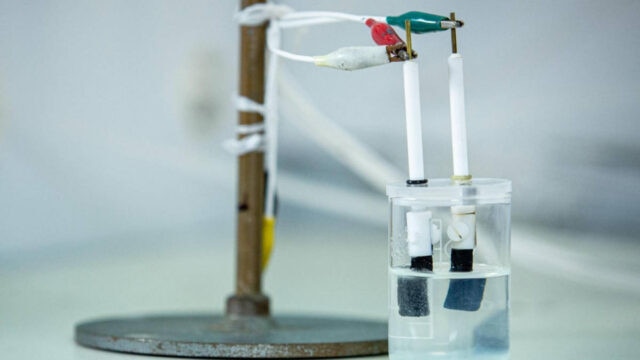Emission Control: RMIT seawater breakthrough could cut green hydrogen production costs
RMIT University scientists have produced hydrogen from seawater in a breakthrough that could mean cheaper and even greener gas.

Emission Control is Stockhead’s fortnightly take on all the big news surrounding developments in renewable energy.
RMIT University scientists have produced hydrogen from seawater in a breakthrough that could mean cheaper and even greener gas.
Much has been made about the high price of green hydrogen and the cost of the electrolysers and renewable energy needed to create it.
However, the cost of getting the correct water to be used as feedstock isn’t discussed so often.
Typical methods of electrolysis require clean water, and purifying it is costly.
In the case of seawater, desalination requires additional energy, which also comes at a cost.
For the latest renewables news, sign up here for free Stockhead daily newsletters
This is especially important because something like nine litres of water is needed to produce about 1kg of H2 (hydrogen gas).
But researchers at Melbourne’s RMIT University have developed a more energy efficient way to make hydrogen directly from seawater, skipping the need for desalination.
The new approach devised by a team in the multidisciplinary Materials for Clean Energy and Environment (MC2E) research group at RMIT uses a catalyst composed of nitrogen-doped porous nickel molybdenum phosphide sheets.

These highly efficient, stable catalysts take little energy to run and can be used at room temperature.
Lead researcher Dr Nasir Mahmood, a Vice-Chancellor’s Senior Research Fellow at RMIT, said the method was simple, saleable, and far more cost-effective than any green hydrogen approach in the market.
It was also more environmentally friendly.
“The biggest hurdle with using seawater is the chlorine, which can be produced as a by-product,” he said.

“If we were to meet the world’s hydrogen needs without solving this issue first, we’d produce 240 million tons per year of chlorine each year – which is three to four times what the world needs in chlorine.
“Our process not only omits carbon dioxide, but also has no chlorine production.”
MORE FROM STOCKHEAD: Company thinks it can produce $2/kg green hydrogen | ‘Dirty Dozen’ in Climate Council sights | The quest for gold hydrogen
Mahmood said the technology could significantly bring down the cost of electrolysers – enough to meet the Australian government’s goal for green hydrogen production of $2/kilogram, to make it competitive with fossil fuel-sourced hydrogen.
A provisional patent application has been filed for the new method, detailed in a lab-scale study published in Wiley journal, Small.
RMIT researchers are working with industry partners to develop aspects of this technology.
Other renewable energy news
CALIX (ASX:CXL)
A project led by Windship Technology, in partnership with Leilac, Calix’s 93 per cent owned subsidiary, focuses on the decarbonisation of cement and lime, and has been awarded $8.73 million by Innovate UK to demonstrate a novel route to zero carbon shipping.
CXL says the project aims to reveal a low-cost route to decarbonise shipping with a combination of renewably powered propulsion and a lime-based carbon capture solution for remaining emissions.
The objective is to design, develop, build and demonstrate a novel drive train system consisting of a single powerful wind propulsion device, working together with a trial carbon capture system to pave the route to zero emission propulsion for bulkers and tankers.
CXL says the shipborne carbon capture system will ultimately be designed to use highly reactive low-emissions-intensity lime, produced in an onshore Leilac reactor, to capture CO2 from the ship’s exhaust gases.
Visit Stockhead, where ASX small caps are big deals
FRONTIER ENERGY (ASX:FHE)
Optimisation work has identified a $9.5 million reduction in capital costs for Frontier Energy’s 114MW solar farm (stage one) at its Bristol Spring green hydrogen project in WA.
The pre-feasibility study (PFS) released last year estimated the total capital cost of the solar facility to be $166 million.
This is mainly through the relocation of the point of connection (POC) to within 1km of the Landwehr terminal (compared to the original design that was at the same location as the solar farm and required 5km of power lines, which reduces the capital cost by about half, or $9.5 million, compared to the PFS estimate of $19.1 million.
ORIGIN ENERGY (ASX:ORG)
Origin Energy’s half yearly results reported a statutory profit of $399 million compared to a $131 million loss in the prior corresponding period as underlying profit declined by $224m, to $44 million.
ORG CEO Frank Calabri said the first half result was mixed, reflecting a higher earnings contribution from Integrated Gas, and contrasting with more challenging conditions for the Energy Markets division, which has resulted in lower earnings from that business.
However, the retail business had performed well, driven by “significant growth of community energy services and the addition of 30,000 customer accounts”.
“Origin Zero is making good progress in partnering with business customers to optimise their demand and supply lower-carbon-energy solutions,” he said.
“We continue to focus on executing our strategy, including accelerating investment in renewable and cleaner energy and customer solutions.”
Calabri added the company’s virtual power plant was growing strongly, with the proposed Eraring battery progressing towards a final investment decision as Origin continues to explore potential hydrogen projects.
This content first appeared on stockhead.com.au
SUBSCRIBE
Get the latest Stockhead news delivered free to your inbox.Click here


